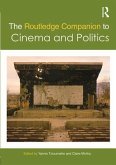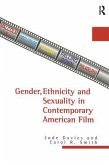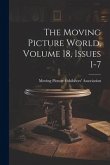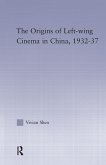Color and the Moving Image
History, Theory, Aesthetics, Archive
Herausgeber: Brown, Simon; Watkins, Liz; Street, Sarah
Color and the Moving Image
History, Theory, Aesthetics, Archive
Herausgeber: Brown, Simon; Watkins, Liz; Street, Sarah
- Broschiertes Buch
- Merkliste
- Auf die Merkliste
- Bewerten Bewerten
- Teilen
- Produkt teilen
- Produkterinnerung
- Produkterinnerung
This new AFI Film Reader is the first comprehensive collection of original essays on the use of color in film. Contributors from diverse film studies backgrounds consider the importance of color throughout the history of the medium, assessing not only the theoretical implications of color on the screen, but also the ways in which developments in cinematographic technologies transformed the aesthetics of color and the nature of film archiving and restoration.
Andere Kunden interessierten sich auch für
![What a Girl Wants? What a Girl Wants?]() Diane NegraWhat a Girl Wants?51,99 €
Diane NegraWhat a Girl Wants?51,99 €![The Routledge Companion to Cinema and Politics The Routledge Companion to Cinema and Politics]() The Routledge Companion to Cinema and Politics50,99 €
The Routledge Companion to Cinema and Politics50,99 €![Gender, Ethnicity, and Sexuality in Contemporary American Film Gender, Ethnicity, and Sexuality in Contemporary American Film]() Jude DaviesGender, Ethnicity, and Sexuality in Contemporary American Film59,99 €
Jude DaviesGender, Ethnicity, and Sexuality in Contemporary American Film59,99 €![The Moving Picture World, Volume 18, Issues 1-7 The Moving Picture World, Volume 18, Issues 1-7]() The Moving Picture World, Volume 18, Issues 1-736,99 €
The Moving Picture World, Volume 18, Issues 1-736,99 €![The Origins of Leftwing Cinema in China, 1932-37 The Origins of Leftwing Cinema in China, 1932-37]() Vivian ShenThe Origins of Leftwing Cinema in China, 1932-3766,99 €
Vivian ShenThe Origins of Leftwing Cinema in China, 1932-3766,99 €![Global Media Ecologies Global Media Ecologies]() Doris BaltruschatGlobal Media Ecologies64,99 €
Doris BaltruschatGlobal Media Ecologies64,99 €![Science Fiction Film, Television, and Adaptation Science Fiction Film, Television, and Adaptation]() Science Fiction Film, Television, and Adaptation45,99 €
Science Fiction Film, Television, and Adaptation45,99 €-
-
-
This new AFI Film Reader is the first comprehensive collection of original essays on the use of color in film. Contributors from diverse film studies backgrounds consider the importance of color throughout the history of the medium, assessing not only the theoretical implications of color on the screen, but also the ways in which developments in cinematographic technologies transformed the aesthetics of color and the nature of film archiving and restoration.
Hinweis: Dieser Artikel kann nur an eine deutsche Lieferadresse ausgeliefert werden.
Hinweis: Dieser Artikel kann nur an eine deutsche Lieferadresse ausgeliefert werden.
Produktdetails
- Produktdetails
- Verlag: Taylor & Francis
- Seitenzahl: 286
- Erscheinungstermin: 19. November 2012
- Englisch
- Abmessung: 226mm x 151mm x 20mm
- Gewicht: 391g
- ISBN-13: 9780415892643
- ISBN-10: 0415892643
- Artikelnr.: 32462389
- Herstellerkennzeichnung
- Libri GmbH
- Europaallee 1
- 36244 Bad Hersfeld
- gpsr@libri.de
- Verlag: Taylor & Francis
- Seitenzahl: 286
- Erscheinungstermin: 19. November 2012
- Englisch
- Abmessung: 226mm x 151mm x 20mm
- Gewicht: 391g
- ISBN-13: 9780415892643
- ISBN-10: 0415892643
- Artikelnr.: 32462389
- Herstellerkennzeichnung
- Libri GmbH
- Europaallee 1
- 36244 Bad Hersfeld
- gpsr@libri.de
Anna Batistova works as the head of audiovisual collections at National Film Archive in Prague (Czech Republic), and an assistant professor at Department of Film Studies and Audiovisual Culture at Masaryk University, Brno (Czech Republic). She does research in history of screening technologies and teaches cinema technology, early cinema, Czech cinema, and audiovisual archiving.
Introduction: Simon Brown, Sarah Street, Liz Watkins I. HISTORY. Chapter 1.
Simon Brown, "The Brighton School and the Quest for Natural Color" - Redux.
Chapter 2. Hilde D'haeyere, Out of the Blue: Color Inserts in Mack
Sennett's Comedy Shorts of the Late Twenties. Chapter 3. Charles O'Brien,
Technicolor Song Sequences: Music and Color in King of Jazz (1930).
Chapter 4. Anna Batistová, Glorious Agfacolor, Breathtaking Totalvision
and...Changing Color Process in Czechoslovak Cinema at the Beginning of the
"Scope" Boom. Chapter 5. Sarah Street, Glorious Adventures with Prizma.
Chapter 6. Andrew Robert Johnston, The Color of Prometheus: Thomas
Wilfred's Lumia and the Projection of Transcendence. II. THEORY. Chapter 7.
Tom Gunning, Where Do Colors Go at Night? Chapter 8. Rosalind Galt,
"Brash...Indecent...Libertine": Aesthetics and Film Theory Versus Derek
Jarman's Queer Colors. Chapter 9. Jocelyn Szczepaniak-Gillece, The Hues of
Memory, the Shades of Experience: The Color of Time in Syndromes and a
Century. Chapter 10. Philipp Schmerheim, From Psycho to Pleasantville: The
Role of Color and Black-and-White Imagery for Film Experience. III.
AESTHETICS. Chapter 11. Joshua Yumibe, The Illuminated Fairytale: The
Colors of Paul Fejos's Lonesome (1928). Chapter 12. Charles Tepperman,
Color Unlimited: Amateur Color Cinema in the 1930s. Chapter 13. Fiona
Handyside, Color and Meaning in the Films of Eric Rohmer. Chapter 14.
Heather Heckman, The Cameraman and the Glamour-Puss: Technicolor
Cinematography and Design in John Ford's Drums Along the Mohawk. Chapter
15. Scott Higgins, Chromo-Drama: Innovation and convention in Douglas
Sirk's Color Designs. Chapter 16. Steven Jacobs, Colour and Set Design in
Alfred Hitchcock's Rope, Under Capricorn, and Dial M for Murder. Chapter
17. John Belton, Color and Meaning in Marnie. IV. ARCHIVE. Chapter 18.
Jason Gendler, Are My Eyes Really Brown? The Aesthetics of Colorization in
Casablanca. Chapter 19. William Brown, "Those Men Are Not White!":
Neuroscience, Digital Imagery and Color in O Brother, Where Art Thou?
Chapter 20. Ulrich Rüdel, Daniela Currò and Claudy Op den Kamp, Towards a
More Accurate Preservation of Color: Heritage, Research and the Film
Restoration Laboratory. Chapter 21. Liz Watkins, Herbert G. Ponting's
Materials and Texts.
Simon Brown, "The Brighton School and the Quest for Natural Color" - Redux.
Chapter 2. Hilde D'haeyere, Out of the Blue: Color Inserts in Mack
Sennett's Comedy Shorts of the Late Twenties. Chapter 3. Charles O'Brien,
Technicolor Song Sequences: Music and Color in King of Jazz (1930).
Chapter 4. Anna Batistová, Glorious Agfacolor, Breathtaking Totalvision
and...Changing Color Process in Czechoslovak Cinema at the Beginning of the
"Scope" Boom. Chapter 5. Sarah Street, Glorious Adventures with Prizma.
Chapter 6. Andrew Robert Johnston, The Color of Prometheus: Thomas
Wilfred's Lumia and the Projection of Transcendence. II. THEORY. Chapter 7.
Tom Gunning, Where Do Colors Go at Night? Chapter 8. Rosalind Galt,
"Brash...Indecent...Libertine": Aesthetics and Film Theory Versus Derek
Jarman's Queer Colors. Chapter 9. Jocelyn Szczepaniak-Gillece, The Hues of
Memory, the Shades of Experience: The Color of Time in Syndromes and a
Century. Chapter 10. Philipp Schmerheim, From Psycho to Pleasantville: The
Role of Color and Black-and-White Imagery for Film Experience. III.
AESTHETICS. Chapter 11. Joshua Yumibe, The Illuminated Fairytale: The
Colors of Paul Fejos's Lonesome (1928). Chapter 12. Charles Tepperman,
Color Unlimited: Amateur Color Cinema in the 1930s. Chapter 13. Fiona
Handyside, Color and Meaning in the Films of Eric Rohmer. Chapter 14.
Heather Heckman, The Cameraman and the Glamour-Puss: Technicolor
Cinematography and Design in John Ford's Drums Along the Mohawk. Chapter
15. Scott Higgins, Chromo-Drama: Innovation and convention in Douglas
Sirk's Color Designs. Chapter 16. Steven Jacobs, Colour and Set Design in
Alfred Hitchcock's Rope, Under Capricorn, and Dial M for Murder. Chapter
17. John Belton, Color and Meaning in Marnie. IV. ARCHIVE. Chapter 18.
Jason Gendler, Are My Eyes Really Brown? The Aesthetics of Colorization in
Casablanca. Chapter 19. William Brown, "Those Men Are Not White!":
Neuroscience, Digital Imagery and Color in O Brother, Where Art Thou?
Chapter 20. Ulrich Rüdel, Daniela Currò and Claudy Op den Kamp, Towards a
More Accurate Preservation of Color: Heritage, Research and the Film
Restoration Laboratory. Chapter 21. Liz Watkins, Herbert G. Ponting's
Materials and Texts.
Introduction: Simon Brown, Sarah Street, Liz Watkins I. HISTORY. Chapter 1.
Simon Brown, "The Brighton School and the Quest for Natural Color" - Redux.
Chapter 2. Hilde D'haeyere, Out of the Blue: Color Inserts in Mack
Sennett's Comedy Shorts of the Late Twenties. Chapter 3. Charles O'Brien,
Technicolor Song Sequences: Music and Color in King of Jazz (1930).
Chapter 4. Anna Batistová, Glorious Agfacolor, Breathtaking Totalvision
and...Changing Color Process in Czechoslovak Cinema at the Beginning of the
"Scope" Boom. Chapter 5. Sarah Street, Glorious Adventures with Prizma.
Chapter 6. Andrew Robert Johnston, The Color of Prometheus: Thomas
Wilfred's Lumia and the Projection of Transcendence. II. THEORY. Chapter 7.
Tom Gunning, Where Do Colors Go at Night? Chapter 8. Rosalind Galt,
"Brash...Indecent...Libertine": Aesthetics and Film Theory Versus Derek
Jarman's Queer Colors. Chapter 9. Jocelyn Szczepaniak-Gillece, The Hues of
Memory, the Shades of Experience: The Color of Time in Syndromes and a
Century. Chapter 10. Philipp Schmerheim, From Psycho to Pleasantville: The
Role of Color and Black-and-White Imagery for Film Experience. III.
AESTHETICS. Chapter 11. Joshua Yumibe, The Illuminated Fairytale: The
Colors of Paul Fejos's Lonesome (1928). Chapter 12. Charles Tepperman,
Color Unlimited: Amateur Color Cinema in the 1930s. Chapter 13. Fiona
Handyside, Color and Meaning in the Films of Eric Rohmer. Chapter 14.
Heather Heckman, The Cameraman and the Glamour-Puss: Technicolor
Cinematography and Design in John Ford's Drums Along the Mohawk. Chapter
15. Scott Higgins, Chromo-Drama: Innovation and convention in Douglas
Sirk's Color Designs. Chapter 16. Steven Jacobs, Colour and Set Design in
Alfred Hitchcock's Rope, Under Capricorn, and Dial M for Murder. Chapter
17. John Belton, Color and Meaning in Marnie. IV. ARCHIVE. Chapter 18.
Jason Gendler, Are My Eyes Really Brown? The Aesthetics of Colorization in
Casablanca. Chapter 19. William Brown, "Those Men Are Not White!":
Neuroscience, Digital Imagery and Color in O Brother, Where Art Thou?
Chapter 20. Ulrich Rüdel, Daniela Currò and Claudy Op den Kamp, Towards a
More Accurate Preservation of Color: Heritage, Research and the Film
Restoration Laboratory. Chapter 21. Liz Watkins, Herbert G. Ponting's
Materials and Texts.
Simon Brown, "The Brighton School and the Quest for Natural Color" - Redux.
Chapter 2. Hilde D'haeyere, Out of the Blue: Color Inserts in Mack
Sennett's Comedy Shorts of the Late Twenties. Chapter 3. Charles O'Brien,
Technicolor Song Sequences: Music and Color in King of Jazz (1930).
Chapter 4. Anna Batistová, Glorious Agfacolor, Breathtaking Totalvision
and...Changing Color Process in Czechoslovak Cinema at the Beginning of the
"Scope" Boom. Chapter 5. Sarah Street, Glorious Adventures with Prizma.
Chapter 6. Andrew Robert Johnston, The Color of Prometheus: Thomas
Wilfred's Lumia and the Projection of Transcendence. II. THEORY. Chapter 7.
Tom Gunning, Where Do Colors Go at Night? Chapter 8. Rosalind Galt,
"Brash...Indecent...Libertine": Aesthetics and Film Theory Versus Derek
Jarman's Queer Colors. Chapter 9. Jocelyn Szczepaniak-Gillece, The Hues of
Memory, the Shades of Experience: The Color of Time in Syndromes and a
Century. Chapter 10. Philipp Schmerheim, From Psycho to Pleasantville: The
Role of Color and Black-and-White Imagery for Film Experience. III.
AESTHETICS. Chapter 11. Joshua Yumibe, The Illuminated Fairytale: The
Colors of Paul Fejos's Lonesome (1928). Chapter 12. Charles Tepperman,
Color Unlimited: Amateur Color Cinema in the 1930s. Chapter 13. Fiona
Handyside, Color and Meaning in the Films of Eric Rohmer. Chapter 14.
Heather Heckman, The Cameraman and the Glamour-Puss: Technicolor
Cinematography and Design in John Ford's Drums Along the Mohawk. Chapter
15. Scott Higgins, Chromo-Drama: Innovation and convention in Douglas
Sirk's Color Designs. Chapter 16. Steven Jacobs, Colour and Set Design in
Alfred Hitchcock's Rope, Under Capricorn, and Dial M for Murder. Chapter
17. John Belton, Color and Meaning in Marnie. IV. ARCHIVE. Chapter 18.
Jason Gendler, Are My Eyes Really Brown? The Aesthetics of Colorization in
Casablanca. Chapter 19. William Brown, "Those Men Are Not White!":
Neuroscience, Digital Imagery and Color in O Brother, Where Art Thou?
Chapter 20. Ulrich Rüdel, Daniela Currò and Claudy Op den Kamp, Towards a
More Accurate Preservation of Color: Heritage, Research and the Film
Restoration Laboratory. Chapter 21. Liz Watkins, Herbert G. Ponting's
Materials and Texts.









